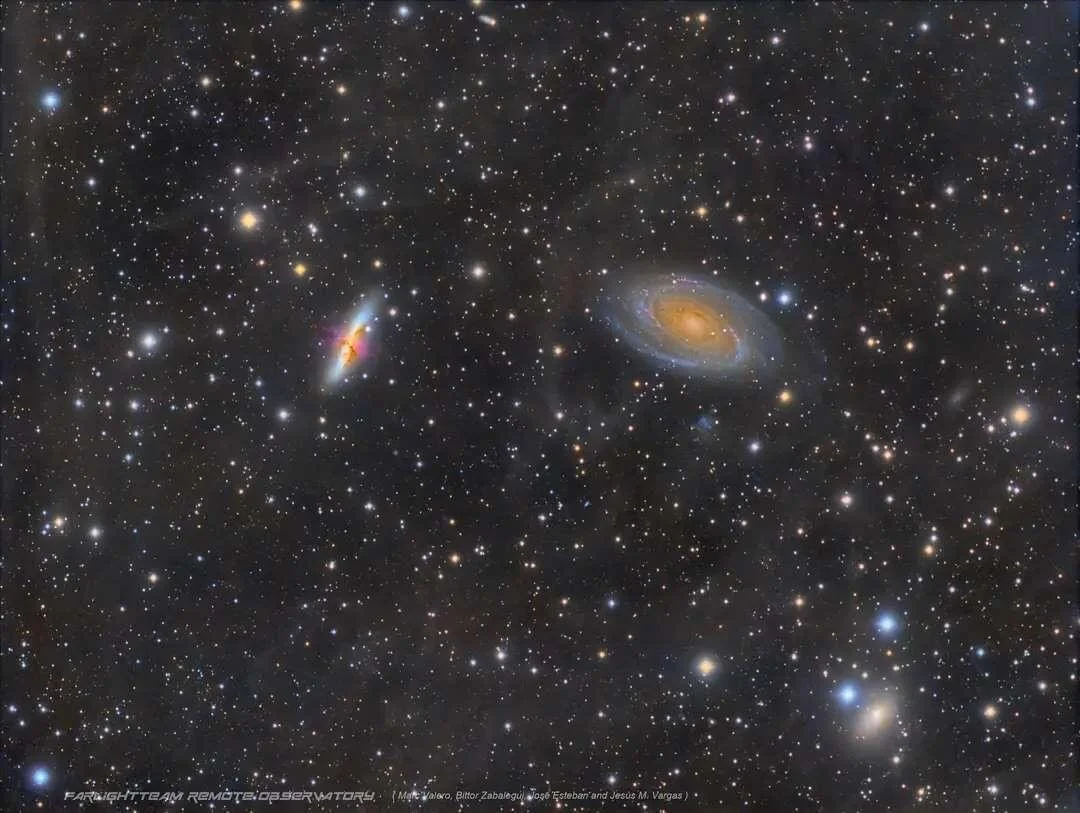
AAPOD2 Image Archives
IC1848 Soul Nebula
Image Description and Details : IC1848 Soul Nebula.
Soul nebula IC1848, narrowband processed. The stars are forming in the soul of the Queen of Ethiopia. More specifically, in a star-forming region called Soul Nebula can be found in the constellation Cassiopeia, a constellation Greek mythology identified as the arrogant wife of a king who has long ruled the lands around the top river Nile. the Soul nebula contains several open clusters of stars, an intense radio source known as W5 and huge bubbles formed by winds from massive young stars. Located about 6,500 light-years away, the Soul Nebula spans about 100 light years.
Technical data:
Remote Observatory "FarLightTeam"
Team: Jesús M. Vargas, Bittor Zabalegui,José Esteban, Marc Valero.
Telescope: Takahashi FSQ106 ED 530mm f/5
CCDs: QSI683 wsg8
Filters: Baader Planetarium - Halpha-SII-OIII
Mount: 10Micron GM1000 HPS
Imaging Software: Voyager
Processing Software: PixInsight-AstroPixelProcessor
Imaging Data:
Captured through 12 December 2021 to 21 February 2022, ( Fregenal de la Sierra ) Badajoz, Spain.
Image composed of a Mosaic of 2 tiles:
Ha: 94x1200"
SII-OIII: 147x1200"
Darks, flats, bias
Copyright: Remote Observatory "FarLightTeam"
Team: Jesús M. Vargas, Bittor Zabalegui,José Esteban, Marc Valero
Sh2-129 / OU4 / Barnard 150
Image Description and Details :
This image has been made from 343 hours of exposure through broadband (LRGB) and narrowband (H-alpha & OIII) filters, composed as an 8-panel mosaic. The result covers an area of approximately 3.50° x 5.10° at 2.09 arc''/pixel resolution. Placed on the surroundings of the constellation Cepheus, this area is rich in several DSOs: We can see Sh2-129, also known as the Flying Bat Nebula, a large and faint HII region showed here in its characteristic H-alpha deep red line.
Superposed to Sh2-129 we see the even fainter Ou4 nebula, colloquially the Giant Squid Nebula, discovered in 2011 by Nicolas Outters, a French amateur astronomer. At first identified as a planetary nebula emitting in the OIII blue-green doublet, it would be in fact the largest in apparent size yet identified, extending over one degree (Acker et al. 2012 - arXiv:1206.2477). However, Corradi et al. (2014 - arXiv:1407.4617) describe Ou4 as the result of a bipolar outflow emanating from a massive component of HR 8119, a triple system located 2,300 light-years away, thus about as far as Sh2-129. If confirmed, this would make it a truly perplexing object.
On the right side of this image appears Barnard 150, or Seahorse Nebula, a dark nebula distant 1,500 light-years, composed by three dense star forming cores, part of an elongated molecular cloud complex. Finally, close to the lower-left end we have identified HD 203025, a Be type star surrounded by a diffuse red nebulosity, captured here through the H-alpha filter. It was catalogued according to its colour and morphology as an IR centred nebula by Bodensteiner et al. (2018 - arXiv:1806.01294), resulting from a massive star member of an interacting binary system.
Technical data:
Telescope: Takahashi FSQ106 ED 530mm f/5
CCDs: QSI683 wsg8
Filters: Baader Planetarium -LRGB Ha OIII
Mount: 10Micron GM1000 HPS
Imaging Software: Voyager
Processing Software: Astropixel, Adobe PS, PixInsight
Imaging Data:
8-panel mosaic captured through July 2021 to December 2021
RGB: 170 x 600” (each). Total 84 hours.
Luminance: 280 x 900”. Total 70 hours.
Ha: 316 x 1200”. Total 106 hours.
OIII: 165 x 1800”. Total 83 hours.
Total Project : 343 hours
Copyright: Remote Observatory "FarLightTeam"
Team: José Esteban, Jesús M. Vargas, Bittor Zabalegui, Marc Valero.
M81 & M82
Well, a first version has already been made with the IFN (Integrated Flux Nebula) processing, clouds of cosmic dust located between the galaxies, specifically this is intergalactic dust that in the background give a somewhat dirty appearance to the image, but they are that, cosmic dust from space, composed of particles smaller than 100 µm.
OBSERVATORY REMOTE FARLIGHTTEAM:
Takahashi FSQ-106 f/5 530mm
CCD QSI 683ws8
Mount 10 Micron 1000
Rotator Pegasus-MGPBox-PowerBox-Armadillo Focuser - Lunatic Zerodew
Voyager software - MountWizar - PixInsight - Adobe PS
Luminance 90 shots of 900 (22`5 hours)
Halfa 56 shots of 900 (14 hours)
Halfa 16 takes of 1200 (5 and a half hours)
RGB 12 shots for each 600 channel (2 hours for each channel in RGB)
Total 48 hours of lights
Darks 60 x900 "+ 60x1200" + 60x600 "
Bias 202
Flats 60xL + 60xHa + 60xR + 60xG + 60xB
Copyright: Jesus Vargas, Marc Valero, Bittor Zabalegui, and José Esteban




